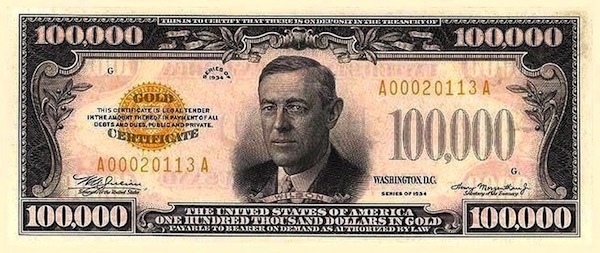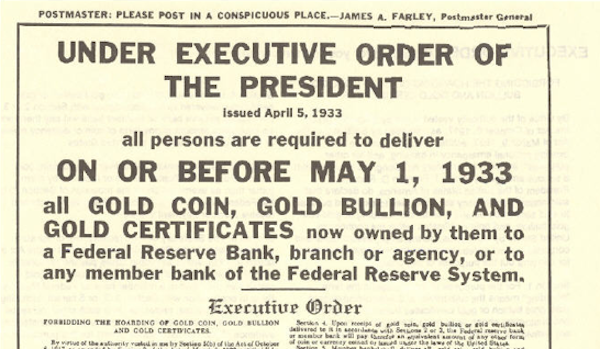A $100,000 Bill?! The True Story Of The Time The U.S. Government Printed It


With so much talk originating around falling off the fiscal cliff, reducing or controlling the national debt, and what to do about a struggling economy, Americans all seem to be looking for an answer in this tough time for the United States. And as much as people like to try to place blame on a certain political party, individual, or decision for the shape of our nation’s coffers, the focus must be on finding a solution, not on the pointing of fingers.
And to be honest, this is not the first…nor likely the last…time that our country has woken up to find itself getting put through the financial ringer. But, thanks to lots of hard work and a few smart decisions, our country was able to bounce back in the past. One such choice was the printing of the $100,000 bill in 1933. While many may have heard that this bill existed, most are not aware of how much it helped to stabilize the economy and reduce massive inflation.
Beginning in about 1929, basic commodity prices began to decline rapidly, creating an economic crisis that would last well into 1934. No one was buying anything with cash and inflation was out of control. To remedy this problem, President Roosevelt issued an executive order asking for the surrender of all gold coin, gold bullion, and gold certificates to the government. The thought was, that if the gold was controlled by the government, gold hoarding, bartering, and other similar activities that were reducing the flow of funds through the government would decline. While this logic was sound and worked to an extent, it was just not enough.

The next step, it seemed, was for the National Treasury to take control of the Federal Reserve’s gold. This was proposed by President Roosevelt as an added way to devalue the dollar, stabilize the economy, and control the gold more closely. While many people were wary of relinquishing control and independence of the Fed, the decision was passed by Congress in early 1933. Along with this decision came the need for the Treasury to print bills in equal value to the gold of the Federal Reserve. This led to the printing of one bill that was worth $100,000.
The $100k bill was actually quite similar to other forms of paper money, and had on it the face of Woodrow Wilson…the President who originally established the Fed. It was, in a way, a gold certificate, that had legal tender within the United States. While the printing of this denomination didn’t stick around, it did seem to help turn the tide of the economic trend in our country. In less than 1 year after printing, the consumer price index showed a steady rising and inflation was well on its way to being controlled and minimized.
While the current state of our country’s finances is not exactly the same as it was under President Roosevelt, there is a striking parallel between the economic woes we are experiencing today and those that were felt in the early ‘30’s. Is it possible, then, to create stability and control inflation today by issuing a large denomination coin or bill? Many advocate the minting of a $1 Trillion coin as a solution. Others, though, feel that the lack of gold to back such a denomination would further complicate the problem.
So, while the decision on whether the government should or should not mint such money is still up for debate, the concept of a large denomination bill or coin is still an interesting thing to think about. What would you do with a $100,000 bill?
[Images via Wikimedia Commons]









































